Measurement of Infiltration Rate of Soil -Ring Infiltrometer Method
The ring infiltrometer method is one of the widely used methods for measuring the infiltration rate of the soil.
Double-ring infiltrometers are routinely used by turfgrass experts, soil scientists, and other professionals to measure infiltration rates of field sites. Measuring infiltration rates is important in proper golf course design development and different situations where estimates of runoff are required.
Factors affecting infiltration rate of soil
1. Soil Texture
Soil texture influences the rate of water infiltration. The infiltration rate is high due to the coarse texture of the soil. But for the fine structure of the soil, the rate of water infiltration is very slow.
2. Rainfall Intensity
If the rainfall intensity is heavy, water impact causes mechanical compaction, which reduces the rate of infiltration. But if the same amount of rainfall occurs with less intensity, it increases the infiltration rate.
3. Temperature
We know that flow is related to viscosity and that the viscosity of water changes with temperature. If the temperature is high, the viscosity of the water will be low, so the penetration rate will be high and vice versa.
4. Quality of water
If the water contains salts and other impurities it clogs the pores of the soil and reduces the rate of infiltration.
5. Soil Moisture content
If the surface soil is moist, the infiltration rate will be low. But if the surface soil is dry, the infiltration rate will be higher.
6. Human Activity
The construction of buildings, playgrounds, roads, and railways results in reduced infiltration capacity.
| Soil Type | Basic Infiltration Rate (mm/hr) |
Sand | Less than 30 |
Sandy Loam | 20-30 |
Loam | 10-20 |
Clay Loam | 5-10 |
Clay | 1-5 |
Ring Infiltration Method
Conventional approaches, if we are talking about head-based methods, is ring infiltrometers. Ring infiltrometers commonly used are single ring infiltrometer and double ring infiltrometer. In the case of a ring infiltrometer a ponded depth of water will be provided, that is, a positive head of water will be causing the flow or causing the filtration. So free flow is allowed there.
Single Ring Infiltrometer
In this method, a thin cylindrical ring is driven into the soil at around 30cm depth. As the name indicates, this single ring is a cylinder having a small thickness. That cylinder will be inserted into the ground as shown in figure1. The cylinder will be inserted approximately 30cm in depth. Sometimes depending on the soil strata, it will be very difficult to insert this much depth, but as much as possible, we will be inserted into the ground. Different types of rings which are having standard dimensions are available. So here, the one which is shown in figure 1 is having a depth of 50cm. out of that, 30cm will be inserted into the ground and 20cm will be above the ground surface. And after that water will be filled in the ring up to 5 to 10cm in depth. Once the water is filled inside the ring infiltrometer, water starts infiltrating into the ground. So, if we are taking this much water infiltrated into the soil within this much time, that will be given as the infiltration rate. Sometimes it can be done in such a way that instead of measuring the lowering of water level, or how much reduction is taking place in the water level, we can maintain a constant level and as the level is dropping down, we can add water into the ring in order to maintain that constant level. So, the volume of water that is added to the ring and the corresponding time will be noted down to get the infiltration rate. So, in both ways, it can be done, either by maintaining a constant head or by measuring the falling head. In the case of a constant level, the rate at which the water is added to the inner ring is measured, and that will give us the infiltration rate. And this experiment needs to be continued until a constant infiltration rate is obtained. Initially, the infiltration rate is high because the soil will be considered in a dry condition. In such cases, water will be infiltrating at a higher rate initially so that, the quantity of water required will be very high. So depending on the type of soil or depending on the moisture which is present in the soil we may have to continue the experiment for a long time until it reaches a constant rate of infiltration.
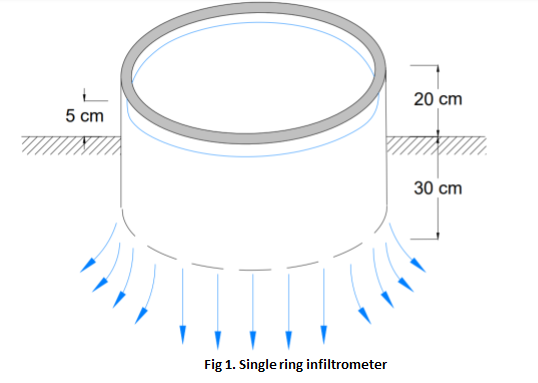
So here you can see, in the middle portion, we are getting the correct downward flow. It can be considered the flow is taking place in the Z- direction or one-dimensional. When it comes to the sides of the infiltrometer, the lateral flow is taking place. You can see the flow slowly spreads in the lateral direction. So in this case the main disadvantage is that we are assuming that the flow is one-dimensional. And at the same time, the water which is infiltrating is not following the one-dimensional path. At the sides of the infiltrometer, it is spreading in the lateral direction. So water gets spread out laterally at the bottom of the ring. So the assumption of one-dimensional flow will not be valid.
Double Ring Infiltration
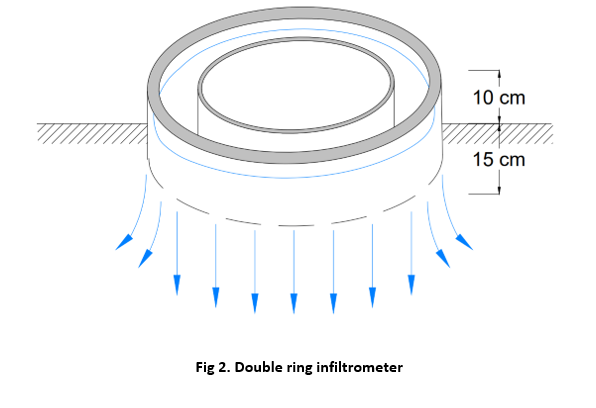
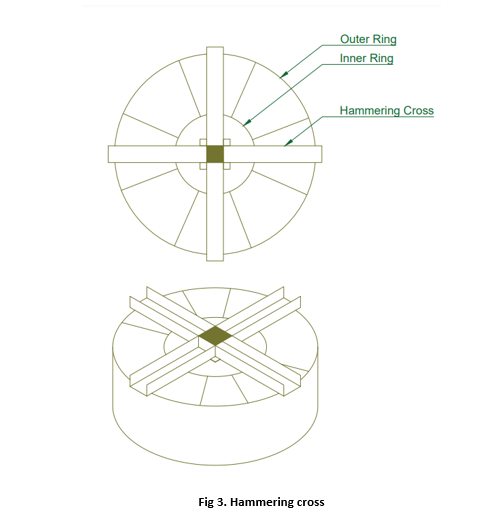
Now we will be recording the drop in water level in the ring. So, while doing the measurement, we are considering only the inner ring. How much water is added or how much lowering of level is taken place With respect to inner ring only. And the rate at which the water is added to the inner ring gives the infiltration rate. So in this case we are using the drop in water level. Otherwise, we can maintain a constant water level and the rate at which water is added between certain intervals of time can be utilized for calculating the infiltration rate. So here, the advantage is that the lateral spreading of infiltered water will be only there at the outer ring. Infiltration below the inner ring remains one-dimensional. If only a single ring is present, the lateral spread will be there which will be causing the extra flow of water rather than what is expected. But in the case of a double ring infiltrometer the lateral flow is from the outer ring. The inner ring is providing only the infiltration rate in the vertical direction.
Now for understanding the process, or for understanding how the infiltration curve will be looking like, we can have a look at one numerical example (Table 1). The table shows the cumulative infiltration depth for an infiltrometer ie the observation we just have to calculate the infiltration rate and also plot the curve.

The time intervals are given in minutes and cumulative depth is representing the water which is infiltrated to the ground. It is not the incremental depth. I.e., From the beginning of the time to till the end of that particular time period is given. Now data given is cumulative infiltration versus time, and we need to find out the infiltration rate and also plot the infiltration curves.
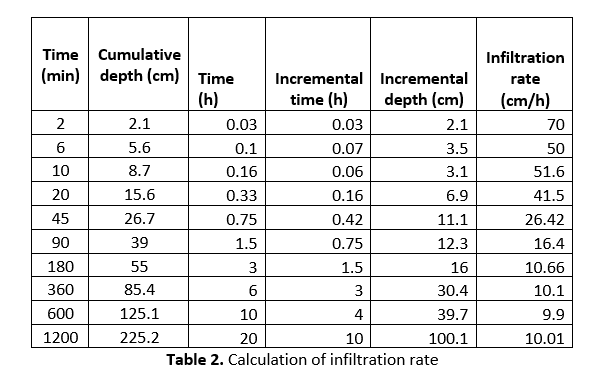
Now we need to convert the time into hours. There is no issue if you are plotting the graph in minutes, but it's around 1200 minutes, so it is better to convert it into hours, which is put in the 3rd column. Now for calculating the infiltration rate, we need to have the incremental time, the ie time interval in which the infiltration takes place. So we are calculating the difference between each increment, which is put in the 4th column. After that we will be finding out the corresponding incremental depth, and how much the depth of water infiltrated within each increment of time which is shown in column 5. Once we divide this incremental depth by this incremental time we can calculate the infiltration rate as shown in column 6.
Now we can plot the infiltration rate curve and the cumulative infiltration depth curve. So when we plot, as shown in fig. initially, high filtration is there. Then it comes down and reaches a steady state value. So this red curve is representing the infiltration rate. And infiltration rate is marked on the primary y-axis. Along the secondary Y-axis, we have cumulative infiltration in centimetres and the time axis is common to both infiltration rate and cumulative infiltration. So this green line represents the cumulative infiltration curve. So when you look at the curve, you can understand that it is an increasing curve. That is every interval water is getting cumulated, and finally, we get the total amount of water infiltrated into the ground. So cumulative infiltration curve will always be an increasing curve, and the infiltration rate curve will be decreasing, and finally, it will be reaching a steady state value.
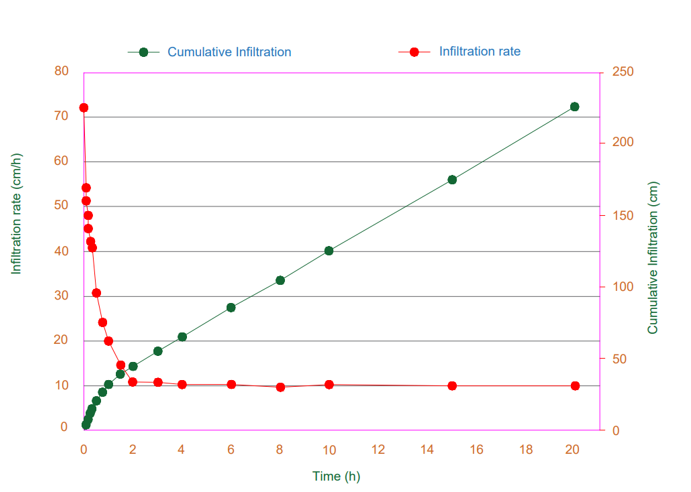
You can see initially the measurements were 2,6,10 ie the time interval is slow and then it increased to 15,30, and finally, you can see 600,1200. So the gap between the time interval is increasing because there are not many changes taking place in the value corresponding to the drop. So that time almost the soil becomes saturated or the rate with which the infiltration is taking place will be lowered. So, depending on that as time elapses you can increase the time duration with which the measurement is noted down.


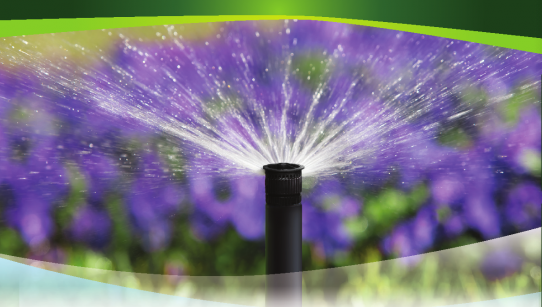




.png)




No comments yet